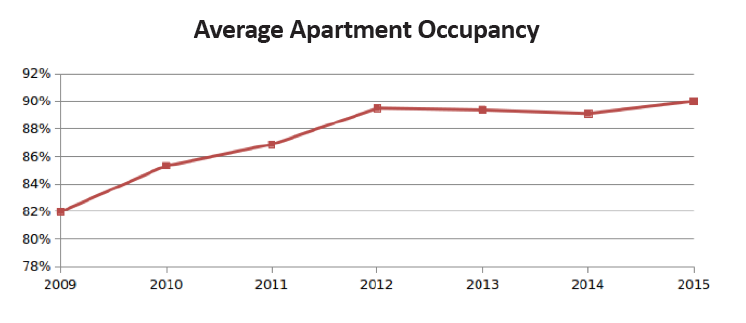Property prices are currently falling and investors registering losses in China’s third- and fourth-tier cities; yet in Beijing, Shanghai, Guangzhou, Shenzhen and the more prosperous of the 2nd-tier urban centers, demand for homes is surging and commercial real estate markets are strong as well. In Shanghai,home prices surged by more than 16% during the first quarter, prompting the government to introduce new buying restrictions.
The national market, in other words, has split int to markets heading in opposite directions. How to interpret this bifurcation, and does it imply that Shanghai and other upper-tier markets are now even more inflated and unbalanced than pre-2013?
At a quick glance that may seem to be the case, but close examination shows otherwise: In Shanghai at least, the big city property market is now more stable than it was during other recent years of rapid home price escalation. Following are three reasons why.
1. The apartment vacancy rate in Shanghai has dropped significantly, from about 18% in 2009 to 10% by 2015. This suggests a decrease in unhealthy speculation.

2. Residential property yields in Shanghai have generally improved. Between 2009 and the end of 2015, apartment rentsrose by 75%, while average purchase price for city apartments increased by about 40%. Yields correspondingly rose fromabout 2% to 2.6% — still very low, but an improvement nevertheless. And 2.6% is comparable to yields in many other ofthe world’s booming megacities.

3. Homes have become more affordable to city residents because average incomes have risen faster than average homeprices. Home prices are still ridiculously high, of course: A worker making the city’s average salary of RMB 71,300 / yearwould need to contribute 49 years worth of his full income to buy a 100 sqm home priced at the city-wide average.But this is nevertheless an improvement over 2009, when the ratio was 56 years. Moreover, an abundance of ar moreaffordable homes are being built in the city outskirts.

Additionally, the excess stock that had built up in Shanghai while transactions stagnated in 2014 has largelybeen sold off. According to Soufun, there were less than 40,000 new homes on the city market at the end ofMarch, or about enough for six months at the current rate of transactions. This compares to sixteen months ofavailable housing stock at the end of 2014 (based on the transaction rate at that time).
Add to all the above the fact that the city’s commercial property market remains strong and has a large amountof new supply in the pipeline, and it does appear that Shanghai has a more stable property market than it had atthe start of the decade. Even though further rounds of government intervention may be required to maintain orincrease that stability on the residential side, owners and investors are operating in a safer market environmentnow than they were five or so years ago.
While we haven’t carried out a similar analysis for other upper-tier cities, the situation in Shanghai suggeststhat the current bifurcated state of the national property market will likely persist for an extended period. Realestate in Shanghai will remain in high demand for the foreseeable future, while resolving problems of excesssupply and feeble economies in the lower-tier markets will still require a significant amount of time.
The Scene

Market Notes
The citywide average rent rose byabout 2.3% during the 1st quarter asonly two new buildings came onlinein the period: the United OverseasBank Building, which brings anadditional 30,000 sqm of office floorspace to Lujiazui; and the secondphase of the Kechuang DongliTechnology Park that brings 70,000sqm to the Caohejing area of XuhuiDistrict.
The average rent should soonplateau and begin falling, however, asa whole 2 million sqm of new supplyis scheduled to enter the market byyear’s end.
The meeting and events facilities inthe podium buildings of ShanghaiCenter opened for business at theend of April.







